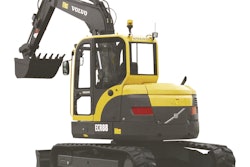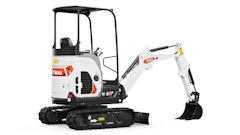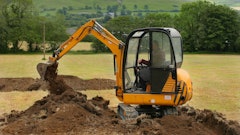
A green stretch of salt marshes, created by conditions left from retreating glaciers, once extended all the way along the East Coast of North America. Over thousands of years, they flourished with life, creating one of the most productive ecosystems in the world. However, thousands of acres of the original marshes were destroyed by the early 1940s to create landfills and man-made roads, or drained for agriculture and mosquito control. In Connecticut, it’s claimed that only 18,000 acres of coastal wetlands remain, but there are now programs in place to preserve and restore affected areas.
The Connecticut Department of Energy and Environmental Protection (CT DEEP) purchased the first of its kind zero gravity marsh excavator for the Fletcher Creek Tidal Wetlands Project at Silver Sands State Park in Milford, CT. The Volvo ECR88D excavator removes harmful plant life from the marshes, giving natural plant species the opportunity to grow and flourish to create a more productive wildlife habitat. It has a bucket capacity of more than 23 cu. ft. and over 20 ft. of digging reach. Its ground pressure around 1.15 psi makes it extremely lightweight and particularly effective when operating in soft marshland that sinks under pressure. The machine works across several marshland sites in order to service as much land as possible.
“The excavator is an absolute necessity here. It’s one of the few pieces of equipment that can come in and dig a channel, and also restore the ponds,” says Paul Capotosto, manager of the Wetlands Habitat and Mosquito Management Program of the CT DEEP.
Outfitted for the Job
The one-year-old excavator worked on The Barn Island Wildlife Management Area project from February until June of this year, digging channels and pools, filling mosquito-breeding depressions on the tidal marshes. Jon Grant, the Volvo dealer representative of Tyler Equipment, has been working with the Wetlands Habitat and Mosquito Management Program for more than 20 years.
“Our operators like using the machine, as it has plenty of attachments and power,” says Capotosto. “It has been modified with low ground pressure tracks by Norris Mfg. from Ohio. The Volvo ECR88D has the option of a GP 4-ft. sloping and clamshell bucket. The ability to interchange buckets makes it the most effective machine in these conditions.”
Chris Norris of Norris Mfg. explains how the machine was adapted for this type of job. “When modifying machines for work in marshland, we widen the undercarriage by 102 in. and lengthen it according to the specific machine, adding extra-wide pads that can lower ground pressure to less than 2 psi,” he says. “Our aim is to reduce the overall weight of the machine by increasing its footprint by 50%. The ECR88D is an excellent machine for this. They are extremely strong and reliable, and the adaptations work well with the existing structure. The extensive Volvo dealer network makes our job a lot easier, and we are able to use Volvo parts wherever possible during the adaptation process. The result is a light, hardworking machine that can be easily transported.”
Working on the Marshes
Each salt marsh project can take four to six months to complete. Plans call for the excavator to be used in saltwater conditions for at least the next 10 years. The WHAMM Program also has five full-time and eight seasonal employees to work on these restoration projects. “The crew works four days a week, 10 hours each day,” says Capotosto. “The Volvo machine will work at least six hours a day, four days a week.”
The reliability of the machine is a crucial part of keeping the work schedule on track. However, there are major challenges that have to be faced, such as the soft marsh conditions and 2- to 3-ft.-wide channels that have to be crossed. In addition, much of the work has to be completed at low tide.
“These projects will help the neighboring communities because it will control salt marsh mosquitoes that can fly up to 20 miles away from their larval breeding areas,” says Capotosto. “Once a project is completed, the salt marsh mosquito population drops to a low count and citizens will notice that mosquitoes are not biting them during the daytime.”




















